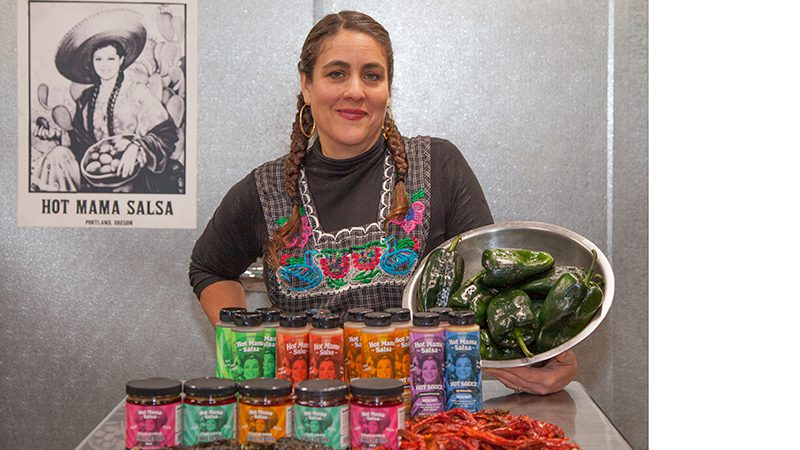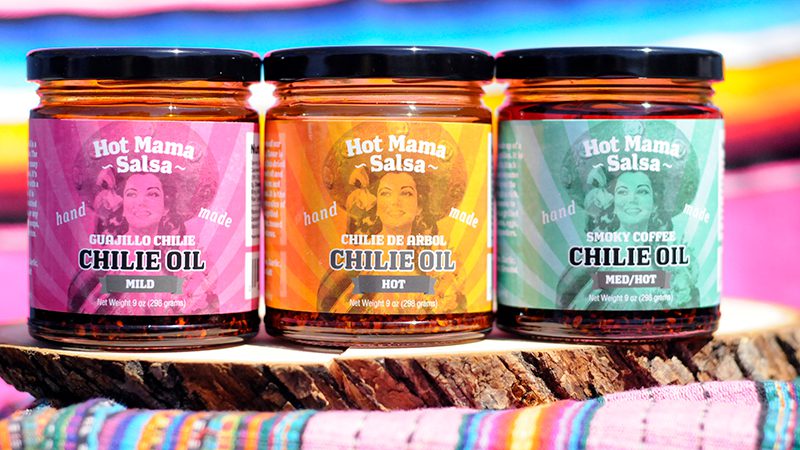Hot Head
Nikki Guerrero’s love for chile peppers fuels Hot Mama Salsa
By Naomi Tomky, guest contributor
This article was originally published in April 2024

Many people complain about the lack of great Mexican food in the Pacific Northwest, Nikki Guerrero actually did something about it. What began as a small project putting fresh salsas on the shelves of a friend’s produce market grew into Hot Mama Salsa, a full range of salsas and hot sauces, and a way for Guerrero to dig deep into the history, culture, and future of her favorite peppers.
Guerrero grew up in Arizona, making salsa and tortillas alongside her grandmother, who immigrated from Monterrey, Mexico before raising her own nine children — including her youngest, Guerrero’s father — in Indiana. When Guerrero moved to Portland, just over 20 years ago, she looked to transition out of a career as a commercial photographer. First, she studied nutrition, but struggled to see her place in the industry. When a friend with a small shop convinced Guerrero to start making fresh salsa for her shelves, Guerrero stepped into the kitchen of a bar next door and stumbled on her new calling.
Handcrafted salsa and hot sauce
Guerrero’s first few salsas in 2008 drew on the traditional versions she learned from her grandmother, but adapted to the culture and tastes of her adopted hometown. “Peanut salsa, at that time, was way too different for people shopping in a grocery store,” she found. She also quickly learned that she needed to tone down the heat in some of her recipes, which led her down a rabbit hole of research on chile peppers.
“There are two kinds of hot sauce,” Guerrero said. “There’s the hot sauce for your food, and then there’s the hot sauce to hurt your friends.” She committed to the former, even though she grew up on spice. Her dad would offer the kids at family parties $20 to eat a whole jalapeño pepper, and he always sliced them onto her quesadillas. But she also saw how her family had adapted their cuisine to new places before: when fresh produce was hard to come by in Indiana winters, her grandmother used canned tomatoes, and their family enchilada sauce calls for a Texas-made spice mix.
That meant when Guerrero’s first nutty, spicy chile oil overpowered Portland palates, she knew to look for a balance of flavor and fruitiness she craved in other peppers. She started using milder guajillo instead of the earthy chile de arbol. The deviation from tradition didn’t bother her. “The idea was to showcase Mexican dried chilies,” Guerrero said. “I’m inspired by different flavors, layers, of chilies, and I really want to express those in sauces.”
As Guerrero branched out from the original grocery store, she started selling at the Portland Farmers Market, which began to function as a testing ground for new flavors, a function it still serves today. Over more than a decade of making salsas and hot sauces, she has seen her audience change, becoming more open to new flavors, more appreciative of traditional Mexican salsas, and most excitingly, far more tolerant of spice.
It also gave her access to local farmers, with whom she worked to grow the peppers she wanted for her sauces locally. It eventually led her to help them find the right seeds and even working with researchers doing seed trials at Oregon Health and Science University as they developed and assessed new varieties of peppers.
“You can write the history of the world through peppers,” Guerrero said. Her love for the peppers goes deeper than simply flavoring her sauces, including the long traditions and various cultures wrapped up into each of the different types — where they traveled to and from and how each place preserves them. Jarring those stories into her salsas and hot sauces brings in flavors from her heritage, but also expands it to other parts of the world, like her Calabrian Chile Paste, while local produce inspires innovations like the La Chava Lavanda, a peach and habanero hot sauce with local lavender.

Fresno chilies and bold flavors
When she started using Fresno chilies from an Oregon farmer, she dug into the story of their development in the 1950s by a farmer named Clarence “Brownie” Hamlin in California’s Fresno Valley. Despite its menacing look, like a pointy red jalapeño, it possesses a complex, citrusy, sweetness. That makes it a favorite for making pepper jelly, but Guerrero decided to really pull out the underlying fruity funkiness by fermenting it with sea salt and garlic and then finishing with a little white balsamic vinegar and creating her Fermented Fresno Hot Sauce.
At the end of 2023, she moved into a larger facility, allowing her to expand her production and make some seasonal flavors in quantities that last all year. But even with the move, she continues her small-batch production of a new sauce for the farmers market each week. Seeing her customers taste her products in real-time helps her gauge how open her customers are to new heat levels or creative combinations of ingredients. “People want more flavor, bolder flavors now,” she said. “People are really excited about trying different international cuisines, which is fun.” She used that openness to weave together the Mexican and Indian uses of tamarind with serrano peppers in her El Tamarindo hot sauce.
Experimentation has always been at the heart of Hot Mama Salsa, from Guerrero’s early days of toning down chile oils, up until now, where she looks for ways to incorporate new favorite peppers into sauces. Over the years, the peppers have led her into new culinary experiences, digging into Spanish recipes as she explored Espelette, Italian with Calabrian, and Turkish spices with Aleppo peppers.
With each pepper she uses, Guerrero considers how she can best express each chile. “I’m so fascinated by them, they are just little jewels,” Guerrero said. “They have such rich layers of flavor and history, and so many unique flavors you can get from them.”
Recently, she dove into locally grown Fatali peppers, a dangerous-looking wrinkly red pointed pepper with habanero-like heat and intense citrus grapefruit aroma. Guerrero calls it the most fragrant pepper she ever worked with — even in the freezer, the smell hits her when she opens the door. Once the hottest pepper in the world, she wove it into a sauce called the Femme Fatali that rounded the spice out with roasted sweet potatoes and pineapple. Because even with the built-in heat of the pepper, Guerrero stays true to how she grew up on chilies: as a way to flavor her food.
Naomi Tomky (naomitomky.com), author of “The Pacific Northwest Seafood Cookbook,” writes about food and travel.
